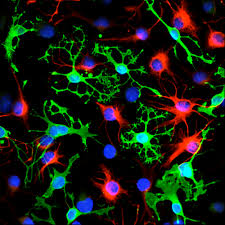Highlights
- •Autofluorescence is a live-cell and label-free marker of NSC quiescence
- •Lysosome-localized autofluorescence is enriched in quiescent NSCs
- •NSC autofluorescence predicts cell behavior in vitro and ex vivo
- •Autofluorescence imaging paired with scRNA sequencing can reveal quiescence substates
Summary
Neural stem cells (NSCs) must exit quiescence to produce neurons; however, our understanding of this process remains constrained by the technical limitations of current technologies. Fluorescence lifetime imaging (FLIM) of autofluorescent metabolic cofactors has been used in other cell types to study shifts in cell states driven by metabolic remodeling that change the optical properties of these endogenous fluorophores. Using this non-destructive, live-cell, and label-free strategy, we found that quiescent NSCs (qNSCs) and activated NSCs (aNSCs) have unique autofluorescence profiles. Specifically, qNSCs display an enrichment of autofluorescence localizing to a subset of lysosomes, which can be used as a graded marker of NSC quiescence to predict cell behavior at single-cell resolution. Coupling autofluorescence imaging with single-cell RNA sequencing, we provide resources revealing transcriptional features linked to deep quiescence and rapid NSC activation. Together, we describe an approach for tracking mouse NSC activation state and expand our understanding of adult neurogenesis.
Introduction
Neural stem cells (NSCs) are responsible for the lifelong production of newborn neurons, a process referred to as neurogenesis, in at least two distinct zones: the subventricular zone (SVZ) of the lateral ventricles and the subgranular zone (SGZ) of the dentate gyrus in the hippocampus.1 Adult NSCs are primarily quiescent (qNSCs), but upon receiving a signal will activate, exiting quiescence and entering the cell cycle. These activated NSCs (aNSCs) can both self-renew and produce progenitors, which expand the population, before ultimately differentiating into newborn neurons, which mature and integrate into the existing circuitry.1 Recent evidence suggests that NSC quiescence exit is the rate-limiting step in adult neurogenesis and is decreased with age and disease.2,3,4,5 Thus, understanding the biology of qNSCs, aNSCs, and the transition from quiescence to activation has become critical to understanding adult neurogenesis. Studies over the past decade have provided insight into the biology underlying NSC quiescence, revealing widespread remodeling of many nodes of cell biology, such as metabolism and the proteome.2,6,7,8,9,10,11,12 However, these studies have been limited by the constraints of modern technologies that exist to identify, isolate, and/or generate qNSCs and aNSCs. For example, intermediate filament proteins, such as nestin and glial fibrillary acidic protein (GFAP), are commonly used as markers to isolate NSCs, yet these proteins are highly differentially expressed in qNSCs and aNSCs.6,10,11,13,14 To gain the most complete understanding of NSC quiescence, new tools with unique capabilities need to be applied.
Many studies have demonstrated the potential of fluorescence lifetime imaging (FLIM) of autofluorescence to study shifts in cell state and behavior in other cell types.15,16,17,18,19 FLIM measures the rate of signal decay of a fluorophore after excitation, called the fluorescence lifetime, which can be used to extrapolate the microenvironment surrounding a fluorophore (Figure 1A). For example, nicotinamide adenine dinucleotide phosphate (NAD(P)H; NADPH and NADH autofluorescence are indistinguishable, and thus NAD(P)H is used to represent the combination) and flavin adenine dinucleotide (FAD) autofluorescence have been used to resolve spatial and temporal dynamics in macrophage metabolism, NSC differentiation, and to classify T cell activation state.15,16,20,21 Autofluorescence imaging capitalizes on the principle that as autofluorescent molecules are used by cells in different ways (e.g., binding to an enzyme, oxidation state) across cell states, identities, or behaviors, their optical properties will change. For example, NAD(P)H is autofluorescent in the reduced state, whereas NAD(P) in the oxidized state is not autofluorescent.22 Conversely, FAD is autofluorescent in the oxidized state but not autofluorescent in the reduced state (FADH2).15,23 In addition to detecting the relative abundance of NAD(P)H or FAD by measuring their fluorescence intensity, FLIM can provide details on the microenvironment surrounding NAD(P)H and FAD, including conformational changes with protein-binding. For example, NAD(P)H has a shorter fluorescence lifetime when it is not bound to a protein (Table 1).17 Conversely, FAD has a longer lifetime when it is not bound to a protein.22,23 NAD(P)H and FAD are known to be involved in hundreds of enzymatic reactions in the cell. Thus, it can be challenging to identify the precise underlying binding partners responsible for changing NAD(P)H and FAD fluorescence lifetimes across conditions. However, regardless of what is specifically driving changes in their fluorescence lifetimes, measuring differences in NAD(P)H and FAD autofluorescent intensity and lifetimes can be sufficient on its own to inform on a cell’s overall behavior. Thus, we asked whether a combination of lifetime and intensity imaging of specific autofluorescent signals (referred to here as optical cell state imaging [OCSI]) could be used to study NSC cell state. We found that OCSI could be used as a non-destructive, single-cell resolution, graded, live-cell, label-free marker to classify the NSC activation state. Using autofluorescence imaging combined with single-cell RNA sequencing of NSCs in vitro and in vivo, we provide resources that reveal the molecular features associated with rapid quiescence exit and deep quiescence. This strategy provides a unique, easily accessible platform to pair a functional readout of NSC metabolism with gene expression, expanding our understanding of NSC quiescence.







